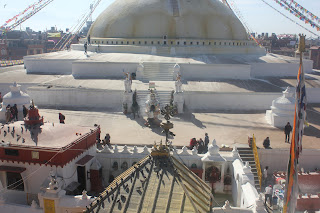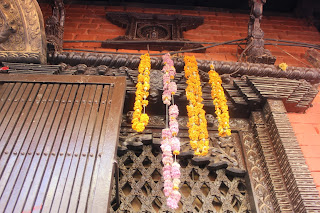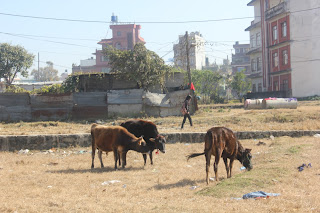The first stop was Boudhanath Stupa, which is the largest spherical stupa in Nepal and the holiest Tibetan stupa outside of Tibet, as well as the center of Tibetan culture in Kathmandu. There are 50 Tibetan monasteries surrounding the stupa, which is pretty cool. It is said to be an eye of Buddha and hold some of his remains at the top of the pyramid. It's located in the town of Boudha on the outskirts of Kathmandu.
 We drove there, which is always exciting and terrifying in Kathmandu, then parked in a random field in the middle of nowhere and walked to the temple. I am not sure why the murder field was the best location to park. It was also filled with cows and goats.
We drove there, which is always exciting and terrifying in Kathmandu, then parked in a random field in the middle of nowhere and walked to the temple. I am not sure why the murder field was the best location to park. It was also filled with cows and goats.This was part of the walk to the stupa.
 And here it is! It was most likely built in the 14th century after the Mughal invasions. It became an important center of Tibetan Buddhism after a significant number of Tibetan Buddhists moved to Nepal after Tibet was invaded by China.
And here it is! It was most likely built in the 14th century after the Mughal invasions. It became an important center of Tibetan Buddhism after a significant number of Tibetan Buddhists moved to Nepal after Tibet was invaded by China.Here is a little information about the statue that I found on this website:
 "From above, Bodnath Stupa looks like a giant mandala, or diagram of the Buddhist cosmos. And as in all Tibetan mandalas, four of the Dhyani Buddhas mark the cardinal points, with the fifth, Vairocana, enshrined in the center (in the white hemisphere of the stupa). The five Buddhas also personify the five elements (earth, water, fire, air and ether), which are represented in the stupa's architecture... At the bottom, the stupa is surrounded by an irregular 16-sided wall, with frescoes in the niches. In addition to the Five Dhyani Buddhas, Boudhanath Stupa is closely associated with the Bodhisattva Avalokiteshvara (Padmapani), whose 108 forms are depicted in sculptures around the base. The mantra of Avalokiteshvara - Om Mani Padme Hum - is carved on the prayer wheels beside the images of Avalokiteshvara around the base of the stupa.
"From above, Bodnath Stupa looks like a giant mandala, or diagram of the Buddhist cosmos. And as in all Tibetan mandalas, four of the Dhyani Buddhas mark the cardinal points, with the fifth, Vairocana, enshrined in the center (in the white hemisphere of the stupa). The five Buddhas also personify the five elements (earth, water, fire, air and ether), which are represented in the stupa's architecture... At the bottom, the stupa is surrounded by an irregular 16-sided wall, with frescoes in the niches. In addition to the Five Dhyani Buddhas, Boudhanath Stupa is closely associated with the Bodhisattva Avalokiteshvara (Padmapani), whose 108 forms are depicted in sculptures around the base. The mantra of Avalokiteshvara - Om Mani Padme Hum - is carved on the prayer wheels beside the images of Avalokiteshvara around the base of the stupa.The base of the stupa consists of three large platforms, decreasing in size. These platforms symbolize Earth, and here you can look out at the mountains while listening to the chants of the devout doing kora, walking around the stupa praying. Next come two circular plinths supporting the hemisphere of the stupa, symbolizing water. As at Swayabunath, Bodnath is topped with a square tower bearing the omnipresent Buddha eyes on all four sides. Instead of a nose is a question-mark-type symbol that is actually the Nepali character for the number 1, symbolizing unity and the one way to reach enlightenment—through the Buddha's teachings. Above this is the third eye, symbolizing the wisdom of the Buddha. The square tower is topped by a pyramid with 13 steps, representing the ladder to enlightenment. The triangular shape is the abstract form for the element of fire. At the top of the tower is a gilded canopy, the embodiment of air, with above it a gilded spire, symbolic of ether and the Buddha Vairocana. Prayer flags tied to the stupa flutter in the wind, carrying mantras and prayers heavenward."

I went into one of the monasteries first, so I could see the stupa from above, which was awesome.

Unfortunately, the spire was damaged during the earthquake and is currently being reconstructed.
I'm not sure what is in those yellow jars, but it seems dangerous near those candles.
There I am!
It was so beautiful around the stupa!!
Here I am again!
This is the Wheel of Life is a Tibetan symbolic representation of the samsara, or cyclic existance, and is believed to have been drawn by Buddha himself.
Each layer represents a different part of existance.
The meanings of the main parts of the diagram are:
The images in the hub of the wheel represent the three poisons of ignorance, attachment and aversion.
The second layer represents karma.
The third layer represents the six realms of samsara.
The fourth layer represents the twelve links of dependent origination.
The fierce figure holding the wheel represents impermanence.
The moon above the wheel represents liberation from samsara or cyclic existence.
The Buddha pointing to the white circle indicates that liberation is possible.

I thought these elephants were really beautiful, especially surrounded by all the colors.
There were a lot of people praying around the stupa, as would be expected since it's a pilgrimage location.


The top of the stupa. You can kind of see the question park shaped nose in this picture.
Afterwards, we walked back to the car and headed to Durbar Square in Patan, but that will be the next blog!
The street we crossed to get the field.
That bus was one of the buses used for public transportation.
Our parking spot.













































































No comments:
Post a Comment